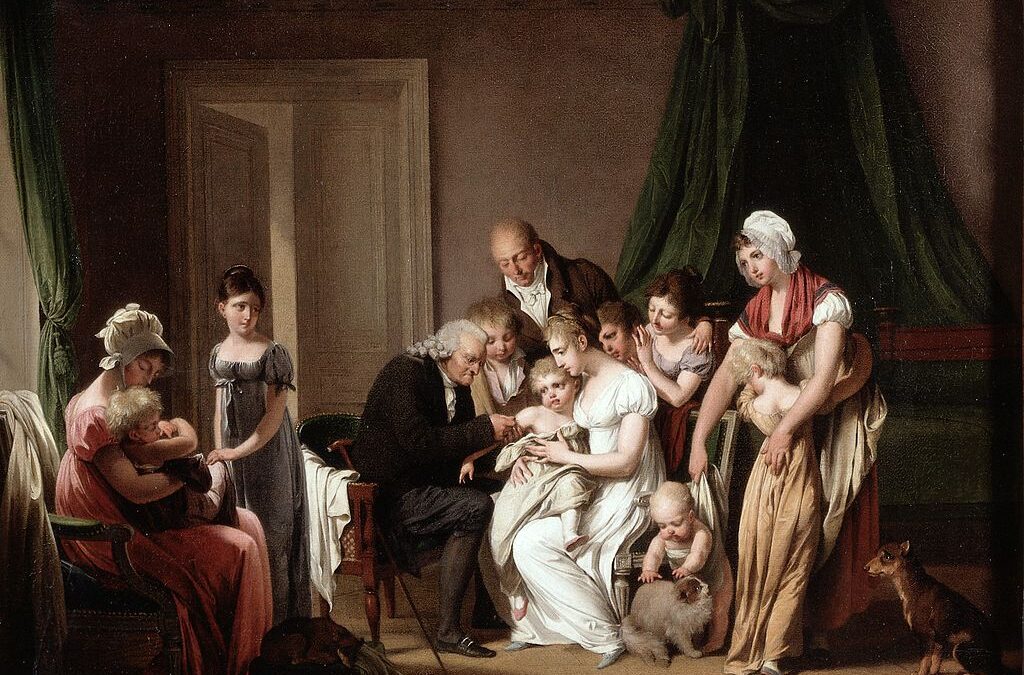During the current pandemic, various rumours and conspiracy theories have emerged about covid vaccines. Opponents of vaccination claim that vaccines are unsafe, or that they alter your DNA. At the more exotic end, some believe that vaccines contain a tracking microchip, or that they are part of a plot by elites to depopulate the world. Perhaps the most bizarre claim made on social media (apparently as part of a Russian disinformation campaign) was that the AstraZeneca vaccine would turn people into chimpanzees.
Anti-vaccination movements seem like a very modern phenomenon, but opposition to vaccination goes right back to the invention of the smallpox vaccine by Edward Jenner in the 1790s. A powerful anti-vaccine movement emerged following the introduction of compulsory infant smallpox vaccination in 1853. The claims made by this movement are strikingly similar to those made by modern anti-vaxxers. Smallpox vaccination was portrayed as being ineffective, dangerous and unnecessary, since smallpox itself was supposedly a minor ailment. At the extreme end, opponents even claimed that vaccination, which used lymph from cows, led to deformations and changes in behaviour, effectively transforming people into cows.
Opposition to smallpox vaccination was expressed from the very beginning. Early critics of vaccination insisted that the procedure didn’t work, and that the existing practice of variolation (whereby smallpox itself rather than cowpox was used to confer immunity) was the only way to prevent the worst of the disease. By making use of pus from cow’s udders, vaccination allegedly introduced ‘bestial humours’ and ‘beastly diseases’ common to cattle into the human body. One opponent of vaccination, the surgeon William Rowley, recorded cases where vaccination had resulted in strange tumours appearing on a patient’s face that made it resemble an ox. Vaccination, it was claimed, produced ‘strange mutations in the mind, as well as in the body’. These ideas were famously mocked in a satirical print by James Gillray.
The Vaccination Act of 1853 made infant vaccination compulsory, while further Acts in 1867 and 1871 tightened enforcement. Parents who refused vaccination could be fined and ultimately imprisoned. Compulsory vaccination represented a significant expansion in the purview of the state. It was accompanied by other illiberal public health measures such as the Contagious Disease Acts, whereby those suspected of being prostitutes could be forcibly examined and confined to a hospital for treatment of venereal disease.
Given this context, it is hardly surprising that compulsory vaccination was seen by its opponents as a tyrannical violation of personal liberties, amounting to ‘medical despotism’. In response, a large anti-vaccination movement emerged, spearheaded by dedicated anti-vaccination leagues and associations. Opposition to vaccination was expressed through mass protests and riots as well as numerous books and regular printed journals on the topic.
Opponents of vaccination claimed that the procedure did not confer immunity or that it actually made patients more susceptible to smallpox. In addition, it was believed to cause various other diseases. While Victorian anti-vaccinators tended to eschew the ‘bestial’ claims of earlier opponents, they still believed that the practice could cause eczma, scrofula, erysipelas, gangrene, dental caries, convulsions, whooping cough, pneumonia, tuberculosis, cancer and syphilis. Opponents were always able to explain away any statistics that appeared to show the benefits of vaccination, presenting an ever-moving target for the medical authorities who sought to debunk their claims.
Just as today, vaccination was often presented as an elite conspiracy: proponents of the practice had effectively captured government, it was said, and they used their power to suppress evidence of its dangers. However, this conspiracy theory was relatively under-developed by modern standards. Proponents of vaccination were generally presented as being motivated by a sincere (if wrongheaded) belief in the efficacy of the procedure, rather than having some larger and more sinister end in mind. They were a vested interest rather than an evil cabal. Vaccination was not seen as part of a long-term plan, and it was not believed to be orchestrated by any evil genius or secret organisation. In these respects, this conspiracy theory was much less elaborate and less extreme than many of the contemporary theories surrounding covid vaccination, such as Bill Gates’ supposed plot to depopulate the planet or impose a totalitarian world government.
As it turned out, smallpox vaccination as practiced in the Victorian period could indeed be dangerous, although nothing like as dangerous as the anti-vaccinationists claimed. Unsterilised lancets could pass on deadly bacterial infections and spread blood-borne diseases like syphilis, as one doctor discovered when he deliberately injected himself with lymph from syphilitic children, hoping to demonstrate that it was impossible to communicate the disease that way. Similarly, initial claims that vaccination conferred lifetime immunity were strongly defended but turned out to be false. The reluctance of medical authorities to acknowledge these matters was highly damaging, gifting anti-vaccinationists with a propaganda victory and setting back the cause of safe vaccination.
All of this underlines the importance of openness and transparency in vaccine science. Proponents of smallpox vaccination were understandably enthusiastic about a procedure that promised to eradicate a terrible disease that is estimated to have killed 300 million people in the twentieth century alone, but this led them to ignore evidence of its dangers. There was no organised conspiracy behind this, as anti-vaccinators claimed, rather it was the result of confirmation bias and groupthink which all of us are susceptible to and which the rigors of the scientific method are supposed to guard against.
The other lesson is that anti-vaccination movements have not always been fringe groups. When it is made compulsory, vaccination has the potential to provoke large-scale opposition. In the face of this opposition, vaccination legislation was amended in 1898 to allow exemptions to parents who were ‘conscientious objectors’ – the first use of this concept in law – and this exemption was expanded in 1907. This effectively marked the end of compulsory vaccination, and the movement went into abeyance. Opposition to compulsory smallpox vaccination was not only a popular cause, it was also ultimately successful.


Recent Comments